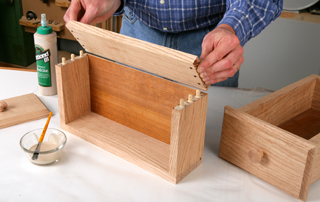
I am a beginning woodworker and need advice on what is a good beading bit for the edge of drawers, shelves etc. I have two routers: one, a Craftsman ( two interchangeable bases) @ 1-1/2 hp. and a 1/4-inch collet; and two, a Triton 2+hp. plunge router w/ 1/4- and 1/2-inch collets. I am also looking for a way to join drawer corners without the use of dovetails ( I just bought a Porter Cable 4212 dovetail machine and haven’t learned to use it yet.) I hope you don’t mind the questions, and I appreciate any help you can give me. – Tony Licata
Chris Marshall: Any beading bit will spruce up the edges of a drawer face, but remember that you can’t use it along all four ends and edges continuously. The bit won’t navigate the corners without cutting through the previous profile. One option would be to cut the bead on separate thin strips of stock and install those around the edges and ends of the drawer face as an applied molding. Miter those corners to keep the beaded profile continuous. If you’re talking about a general profiling bit (chamfers, ogees, roundovers, etc.) those are other drawer edge options, too, and they can be used all around a drawer face without adopting special techniques. Regarding your drawer joinery question, there are numerous options here, but what you choose will depend on how fussy you are about appearance, how strong the drawers need to be and what tooling methods you have available. Rabbet-and-dado joints, box joints, butt joints reinforced with dowels, nails or screws, etc., can all work for drawer joinery — and there are many, many more options with router bits. Alternately, I encourage you to take a Saturday and get familiar with that Porter-Cable jig. Why not? You own it already, and with some practice you can make dovetails — which is exactly why you bought it. Dive in!
Tim Inman: Rabbet joints can make nice drawers. In fact, probably more drawers are rabbetted together than dovetailed. Butt joints are sometimes found, too. In today’s throwaway world, you’ll even find boxes nailed to drawer fronts with virtually no good joinery involved. So, whatever brings the edges together can make a drawer. Learn how to dovetail, though, if you’re interested in fine furniture making. (Eventually, you should put down the routers and pick up a simple hand saw and chisel. Learn how to make handmade dovetails! It is easier than you might think, and the paragon of fine furniture drawers.)
As for bits, well! The sky and your budget are the only limits. If you’re a beginner, then copy the masters. Go look at furniture you like, and observe the profiles they have used. Then, start picking up bits that will produce those edges for you. There is no one right bit. I’d recommend you consider a beginner’s assortment set if your finances will allow it. Sounds like you have some nice routers. Learn to use them with finesse. Brute force is not a good substitute for skill in routers and fine furniture making — or in anything else I can think of…. Above all, experiment and keep samples of your cuts. Seeing the ‘negative’ image when looking at the edge of a bit is one thing. Seeing the ‘real thing’ when you have an actual sample is far superior when trying to pick the right bit for the next job.





